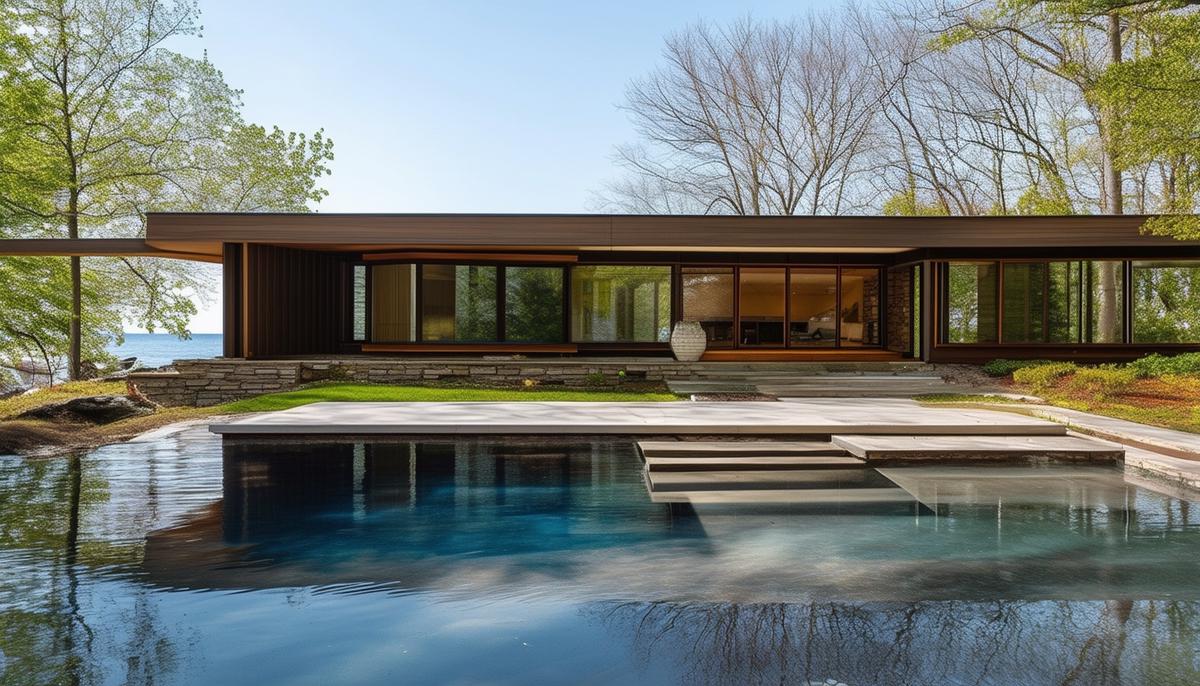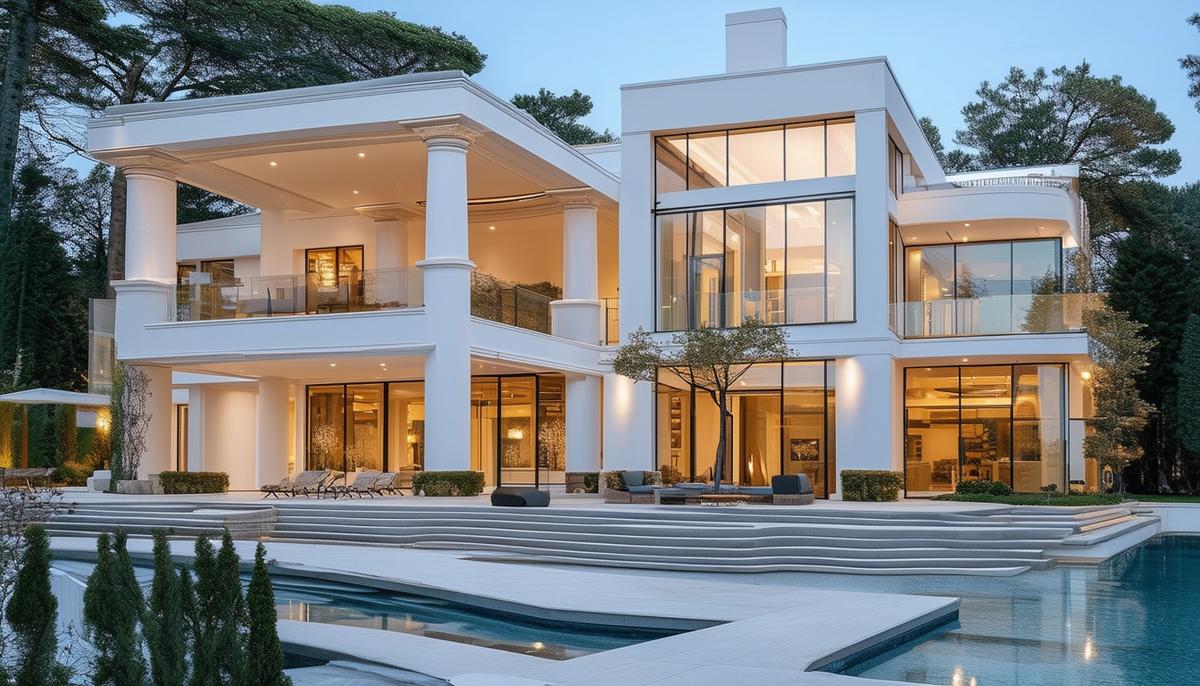Greek architectural elements are making a stylish comeback in modern homes. From columns to pediments, these timeless features are being reinterpreted to blend classic elegance with contemporary design. Whether it's the seamless integration of indoor and outdoor spaces or the use of natural materials, today's architects are finding innovative ways to incorporate Greek influences into their creations.
Greek Architectural Elements in Modern Homes
Columns, pediments, and symmetry reign supreme in Greek architecture, and they're making a comeback in modern homes. Let's explore some contemporary examples using these classic Greek elements.
- The Acropolis Museum in Athens by Bernard Tschumi Architects showcases an interior loop arranged chronologically, floating above an archaeological site.
- The Onassis Cultural Centre in Athens combines an opera house, amphitheater, library, and more, wrapped in a monolithic screen façade with open-air seating.
- The "Eight" office complex in Marousi, Greece, features a faceted white façade and minimalist interiors.
- The Aristotle University Research Dissemination Center in Thessaloniki stands out with its striking red façade.
- Placebo Pharmacy in Irakleia features a perforated façade and radial circulation paths.
- The Museum of the Environment in Peloponnese, made of local stone, offers scenic valley views.
- The Municipal Building of Lambeia merges landscape and building using informal spaces and local materials.
In the United States, Greek influence is evident in iconic structures like the Capitol, Supreme Court Building, and Lincoln Memorial. The Virginia State Capitol and Monticello also blend classical elements with Renaissance ideas.
Modern resorts, like the Grecotel Amirandes Exclusive Resort in Crete, reinterpret Greek elements with clean lines, strategic use of materials, and a touch of classic tranquility.
These examples show how Greek architectural elements continue to inspire and shape modern design, turning everyday spaces into architectural marvels.

Case Studies: Iconic Modern Homes with Greek Influence
Let's explore some modern homes that have gracefully adopted Greek architectural elements:
- A mid-century home overlooking Lake Michigan, revamped by architect Celeste Robbins, features an open layout with symmetry and clean lines.
- The East Hampton Edge by Matt Berman of Workshop/APD reimagines gable forms, inspired by Greek pediments.
- Jenni Kayne's New Zealand coastal retreat, designed by Jeff Fearon, features timber-clad geometric volumes.
- In Los Angeles, a modern residence by Woods + Dangaran boasts 12-foot ceilings and plaster walls.
- The Lauder family guest house on Long Island, rebuilt by Michael Lomont, features a rectilinear form shielded by a mahogany rain screen.
- A 1968 cabin in Deer Isle, Maine, designed by Emily Muir, showcases minimalist rooms with expansive glass fronts.
- A Manhattan townhouse, refreshed by Devin O'Neill, features a top floor that combines Greek elegance with modern design.
- In San Antonio, a stone workers' cottage transformed by Lake | Flato blends old and new, featuring a pool and pergola.
- A Montecito residence by Jamie Bush incorporates fire-resistant design with green interiors.
- Christina Seilern's vacation home on a Greek island captures the essence of simplicity and tranquility.
These homes demonstrate how Greek architectural elements enhance the beauty and functionality of modern living spaces while adding unique contemporary flair.

Adaptation and Innovation of Greek Architecture in Contemporary Design
Modern architects are reimagining Greek architectural elements with innovative twists. They're blending traditional features with contemporary materials and sustainable practices.
The National Museum of African American History and Culture in Washington, D.C. pays homage to ancient silhouettes while using advanced materials for longevity.1
Sustainability is a key focus in modern adaptations. The Grecotel Amirandes Exclusive Resort in Crete uses energy-efficient concrete, wood, and glass to maximize natural light and air, grounded in Greek simplicity.
Innovative use of materials brings historical vibes into contemporary designs:
- The Placebo Pharmacy in Irakleia features perforated facades for natural light and privacy, with spiraling ramps and radial plans adding a modern touch.
- The Aristotle University Research Dissemination Center in Thessaloniki combines sustainability with style through its perforated red façade, improving airflow and reducing energy costs.
- The blending of indoor and outdoor spaces, as seen in Xana Ducci's Greek-island-inspired home, nods to natural ventilation and cooling methods perfected by the Greeks.
These adaptations create smart, sustainable innovations that respect tradition while embracing modern needs. They prove that Greek architectural elements can be seamlessly integrated into contemporary homes, offering both aesthetic appeal and practical benefits.

Modern homes that incorporate Greek architectural elements offer more than just aesthetic appeal; they create sanctuaries where tradition meets innovation. By blending historical reverence with contemporary flair, these designs provide a unique living experience that celebrates both the past and the future.
"Architecture should speak of its time and place, but yearn for timelessness." – Frank Gehry
So, as you look around your home or plan your next project, consider how these timeless features can enhance your space and bring a touch of ancient elegance into your everyday life.
- Adjaye D, Allison P, Byard P, Davis T, Freelon P, Herzogenrath B. History, identity, and purpose: The National Museum of African American History and Culture. Architectur Rec. 2016;204(10):82-91.

